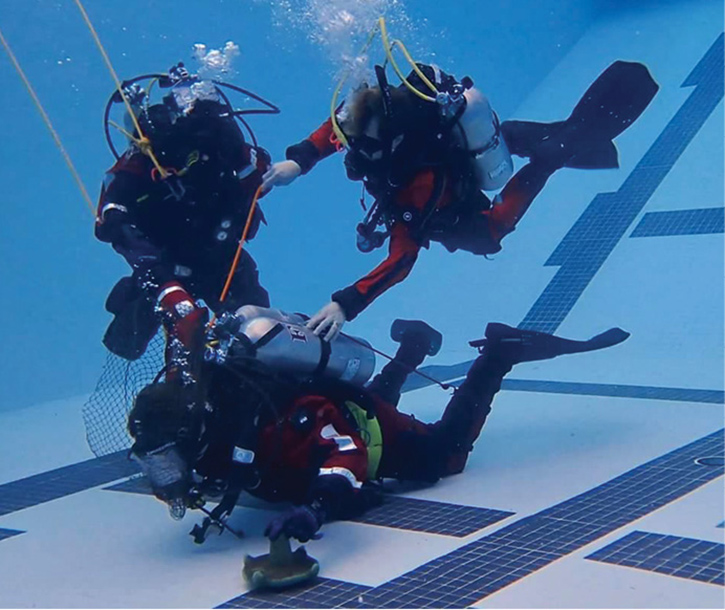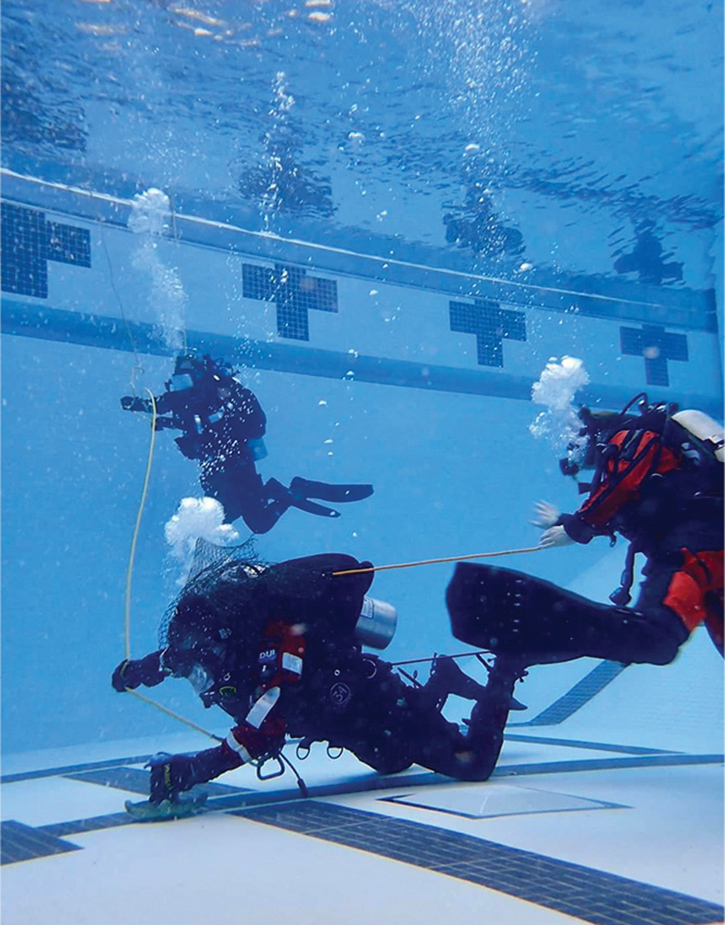
Professional firefighters and public safety divers (PSDs) strive to achieve and maintain safety, comfort, and job-specific proficiency. This should be the case for every diver on the team regardless of years on the job. The reality is that this level of comfort and proficiency is seen mostly in newly trained divers. Soon after, they, too, start falling into the lull created by a lack of operational runs and, in some cases, hands-on training. After the initial dive training period wears off, many teams get lazy and develop the mentality, “We are experienced divers; the job is straightforward, and we don’t need training.” Or, we make our training match our run load, which is the totally opposite of how we should be thinking and training as PSDs.
RELATED FIREFIGHTER TRAINING
Training Options for Your Dive Team
Dive Rescue Series: Dive Team Trainees Learn to Make Rescue a Reality
DIVE RESCUE SERIES: LOCATING YOUR OBJECTIVE
Water-Related Missing Persons Operations
Your newest divers should not be your most comfortable and proficient divers; all team members should be on the same level. How do you maintain the comfort and proficiencies of all team members? How do you prevent the routines, the lack of training, and the career-ending mentality of “We are good enough”? You hit the Pause button and reevaluate every diver on your team, the equipment you are using, and the way you are diving. If you can stay on top of it, you can predict it; if you can predict it, you can prevent it.

Job performance review: (1) A diver is swimming in a set pattern and is presented with a single-problem entanglement by the instructor. (Photos courtesy of Casey Sweeney.)

(2) The diver signals for the backup diver to assist in clearing an entanglement as the instructor evaluates.
When to Push the Pause Button
If some of the above warning signs apply to your dive team, it is time to take a step back, pause, and evaluate not only the divers but also the equipment they use, operational procedures, and the quality and quantity of your training. Near misses and PSD fatalities are real and occur annually. No team is immune, and every team is responsible. Pushing the Pause button and reevaluating your team in basic skills from time to time will drastically reduce and, in some cases, eliminate PSD near misses and fatalities. It also will instill comfort and control in the team. Just when you think your team is properly trained and ready is the time when you should start reevaluating the team’s abilities in diver survival and basic skills because that’s when things go wrong. Complacency kills.
How to Push the Pause Button
The dive team supervisor should request the evaluation. Coordinating it will necessitate buy-in from the administration and be administered by certified or in-house instructors. Such an evaluation should be conducted annually and can be done by an outside agency or through a panel or group in-house by scuba-certified personnel. Some divers may balk at the idea. Explain that the evaluation will be a structured whole-team evaluation, which will include a review of basics and whose goal is “polishing” the team’s performance. In effect, it will be a job performance review (JPR) for diving! Use the basic JPR format: Establish known skill sets and your expectations; offer remedial training and one-on-one time for members who need to improve their proficiency levels.
What the Pause Button Is Not
During this pause is not the time to cut a diver from the team or pursue a head-hunting mission. It is a time to bring the team up to speed on the basics by increasing members’ confidence and hands-on job-specific proficiencies. The goal is to eliminate near misses and prevent fatalities by bringing all team members up to the same standard. The intent is not to haze or call out your divers; it is to reinforce what is expected from the dive team and to make divers aware of performance standards and to help them step up their game.
It also is not the time to train a new diver. Having an established and accredited public safety diver training program is key to the safety and proficiency of every PSD team. If your team is operating under a recreational dive certification, look into a public safety-specific training program. There is nothing recreational about the way PSDs perform in an operational life safety role.
The Evaluation and JPR
The requirements for a public safety diver include proficiencies in basic scuba skills, basic problem solving, stress and survival skills, and basic equipment setup and maintenance. Assess the knowledge of the basic skills in the evaluation, and touch on them throughout the year. Start with basic single problems, and work your way into multiple problems, adding stressors as time and diver comfort allow.
Have the dive team coordinator and the instructors create the JPR form. Each skill on the form should be accomplished by each diver, evaluated by the instructor, and reviewed with that diver. Using the categories of Pass, Fail, and Remedial, the diver receiving a Pass score moves to the next skill, the diver receiving a Fail shall immediately be given a review of the skill and be retested, and the diver receiving a Remedial score shall have an instructor review the whole chapter regarding the failed skill and retest the diver at a later date. Using this format will allow you to make any needed revisions to future JPR forms and to ensure that the material is presented to all divers in the same manner. The time frame within which to conduct the evaluation will depend on the size of the team and the hours available for training. Larger departments may have to make it a multiday session, training each shift and multiple companies daily.
Conduct the evaluation in a pool and a controlled environment with only certified instructors. Equipment used should be issued PSD items used on an operational dive. Clearly explain to the members each section of the schedule and what is expected of them. There should be no surprises. Instill the “Train as you work and work as you train” principle.
Establish tag lines that lead to basic single problem-solving skill stations such as weight belt removal, mask removal, suit or inflator hose malfunctions, lines to cut stations, and lines for deploying the backup diver for Diver Needs Assist Drills. As time allows, implement minor stressors as the diver follows the tag line, and have the diver wear a blacked-out or taped mask or keep his eyes closed. Work up to multiple problems and more stressors as members’ comfort, confidence, and proficiency levels increase. All training should start at the basic level and progress, building muscle memory; introduce new potential problems and stressors the divers may encounter on calls in your jurisdiction.
If a diver shows a lack of comfort, confidence, or proficiency, document it on the JPR form, review it with the diver, and offer remedial training immediately. Establish a time frame for the diver to complete remedial work, and schedule a reevaluation session. Always offer remedial training to achieve the goal. There is no master PSD certification out there; we should all strive to be masters in PSD basic skills and in dealing with entanglement and stressors.
Equipment and Procedures
Too often, teams get so comfortable with their gear and procedures that they tend to disregard improved and up-to-date methods and procedures that provide options for increasing diver performance and safety. Public safety diving equipment is always evolving. Changes, however, cost money and necessitate retraining divers. Some departments ignore the changes and try to ride out older equipment because of laziness, not wanting to train, or complacency about what works better. A good way to recognize this is to ask the question, Is the equipment you are using now specific to the type of environment in which your divers are working? Standardization and protection are the key factors pertaining to the equipment used by PSDs—ensuring proper fit and that all divers set up, break down, decon, and maintain all PSD equipment the same way.
The good thing about procedures is they are not set in stone and can be reevaluated and changed. It is good to revisit them annually and implement changes as needed. As our job and the environment around us change, so should our equipment and procedures. The fire component of our job has been improved; so should the scuba PSD side.
SCOTT HUFF is a 20-year veteran of and a lieutenant in the Indianapolis (IN) Fire Department (IFD) Tactical Rescue Station and Ladder 7. He is a public safety scuba instructor, water rescue trainer, field training officer, shift training officer for IFD, and rescue team manager for US&R IN-TF1. He was the dive team commander from 2009 to 2015 and is a corporate trainer for Dive Rescue International; he conducts hands-on training nationally and speaks at conferences for public safety dive teams.

